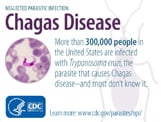Epidemiology & Risk Factors
Chagas disease, or American trypanosomiasis, is caused by the parasite Trypanosoma cruzi. Infection is most commonly spread through contact with the poop of an infected triatomine bug (or “kissing bug”), a blood-sucking insect that feeds on humans and animals.
More on: Triatomine Bugs
Infection can also occur from:
- Mother-to-baby (congenital),
- Contaminated blood products (transfusions),
- An organ transplanted from an infected donor,
- Laboratory accident (rare), or
- Contaminated food or drink (rare).
Chagas disease is common in parts of Mexico, Central America, and South America where an estimated 8 million people are infected. The triatomine bug thrives in poor housing conditions (for example, mud walls, thatched roofs), and where the bug is present, people living in rural areas are at greatest risk for getting infected. Efforts by the public health community to prevent transmission of T. cruzi have resulted in a decrease in the number of new T. cruzi infections and, in some areas, have completely stopped transmission of the parasite by triatomine bugs. Countries where Chagas disease is common have also started screening donated blood for this disease. However, new cases of Chagas disease transmitted from mother-to-child (congenital) can still occur.
CDC estimatesexternal icon that more than 300,000 persons with Trypanosoma cruzi infection live in the United States. Most people with Chagas disease in the United States were infected in the parts of Latin America where Chagas disease is found. Although there are triatomine bugs in the United States, only a few cases of Chagas disease from contact with the bugs have been documented in this country.
More on: Triatomine Bug Identification
